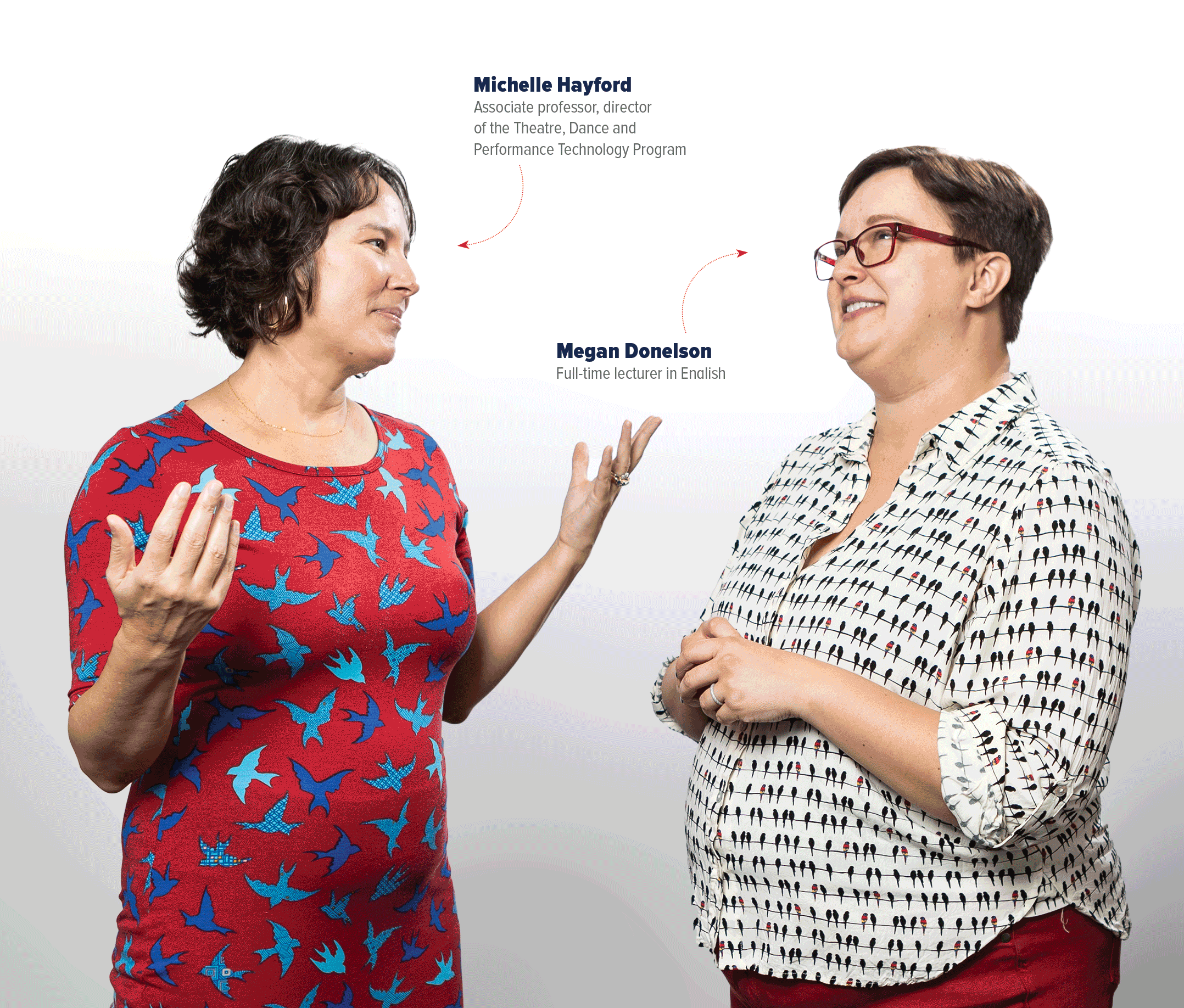Creative approach to empathy
Michelle Hayford: I’ve long wanted to work with the Montgomery County (Ohio) Office of Reentry, and this seemed like the perfect marriage of content and purpose to bring to them. I reached out to Jamie Gee, manager at the Reentry Center, and proposed the opportunity to work together, bringing UD students interested in exploring vocation together with Reentry Career Alliance Academy participants who are doing the same, under very different circumstances.
Megan Donelson: I was lucky to be paired with Michelle, who already had established a relationship with a community partner and had a clear idea of how the students and the community partner could benefit. I wanted to learn how to make those community partner relationships and how to fit learning objectives to what the partner needs.
When I came to UD in 2021, I started teaching health literacy and social justice; there’s a clear opening there to do community-engaged work. For our section of the Educating the Whole Person minicourse, I wanted to see what I could learn and adapt to use later for that course.

MH: For the minicourse, students read about community-engaged learning and the common good, and they generated creative writing. They also participated in applied theater activities, which uses drama in an educational, developmental or therapeutic context. What was compelling to me from the outset was that both formerly incarcerated returning citizens and college students are thinking about vocation from very different lenses, but both are asking the same questions: What is my purpose? Why am I here? How do I serve? What am I meant to do with this one precious life? For me, that was a compelling parallel within these two communities, and I wanted to bring them together to explore those questions.
MD: I have an MFA and a doctorate, so I had a creative writing background before I switched gears into rhetoric. I’ve always found that those two modes — academic writing and creative writing — really inform each other and strengthen skills in the other area for students.
As part of the minicourse, we were talking about having authority over your own narrative. We did exercises in blackout poetry with the students, where you take a text and block out the parts that you don’t want included. You’re left with something completely different, in terms of intention and message, than the page you started with.
MH: That in-class activity was valuable because, in a lot of ways, returning citizens too can relate. You are given this text. How do you speak against it, speak with it, speak to it and take ownership of it? There was something very interesting about not allowing the text to have all the authority; you are imposing your own story onto it.
MD: We only had time to do blackout poetry with our students, but I would love to see the returning citizens do this exercise someday. I brought in texts like the United Nations Universal Declaration of Human Rights and Ohio state laws about administration of prisons.
It was really interesting to see these very official, objectifying narratives shift purpose.
MH: Our students joined the reentry citizens for two modules of the county’s Reentry Academy: social responsibility and spirituality. The students had been reading and discussing the benefits and limitations of the common good and community-engaged scholarship, including ethical considerations needed when doing community-engaged work. The classes are story based, and the instructor, Alice Diebel, allows folks the opportunity to share from their own life experiences. It’s a very safe space. It was quite powerful to think about social responsibility from the context of, I’ve served my time, I paid my debt. And now what do I owe myself and my community?
The students were also very vulnerable and open in sharing from their own experiences, trying to find their way, what their vocations are.
We processed the sessions through theater exercises. I had the students think back on the things that were shared and then physicalize those by recreating what the experience was like through still body shapes. I would then go around the room and tap on the students’ shoulders and hear the interior monologues. What is this character in this tableau thinking in this moment?
MD: Throughout the course, we focused on empathy. That’s a top priority for all of my teaching in general. We go beyond those ideas of pity or charity to a kind of empathy that’s really relating to someone on a more human level. And I think the students got that.
MH: During the minicourse, we planted the seeds to continue working with the reentry center. We will pick up at the end of this semester, and then start rehearsing in earnest next semester, for a performance featuring UD students and returning citizens that will premiere in March in UD’s new Roger Glass Center for the Arts, as part of our weekend of repertory shows.
It’s an opportunity for them to be given a platform in the community.
MD: As a result of the minicourse, fall semester I added a project to the social justice English course where students take a small step in advocacy. They did the research on a health equity issue, became mini-experts, then tried to figure out what they can do. They could write a letter to a state representative. Some of them started petitions circulated through social media. It all came out of their own interests in health equity. Advocacy can feel really hopeless against these big problems, but then we worked on breaking them down to smaller actions that might make a difference for somebody. I hope that I restored their hope a little bit by the end of the semester. It’s another way to practice and build empathy.